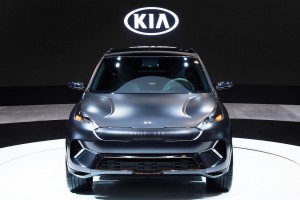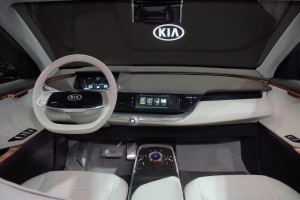
The Kia Niro EV will be available later this year and boasts range comparable to the Chevy Bolt and Tesla Model 3.
Late to the “eco” party, Kia is rushing to catch up, revealing the new member of its Niro family during a preview at the Consumer Electronics Show in Las Vegas.
Like much of the Korean carmaker’s current line-up, the new EV features stand-out styling – while not opting for the sci-fi look that many competitors have adopted for their own battery-based models. Instead, the Kia Niro EV is designed to address several problems that have put off many potential battery-car buyers: range and charging times.
The production version of the Niro EV, which will reach showrooms later this year, will deliver an estimated 238 miles per charge, roughly the same as the Chevrolet Bolt EV and more than the Tesla Model 3. Meanwhile, using a Level 3 charger, the Korean electric vehicle will be able to extend its range by 115 miles in 30 minutes.
The Kia Niro EV concept is slightly larger than the first two – hybrid and plug-in – versions of the Niro. That’s largely because of a thicker floor pan needed to hold the additional lithium-ion batteries the crossover requires, Hyundai officials noted during a roundtable discussion following the EV’s debut at CES. The Niro EV will rely on a 64 kilowatt-hour battery, in line with long-range models like the Bolt and Model 3.
(Kia to reveal new EV concept at CES. Click Here for the story.)
That’s more than double the size of the 28-kWh pack used in sibling brand Hyundai’s Ioniq EV, even though both products share some of the same underlying platform components.
The battery pack will power a 150 kilowatt electric motor. That translates into about 201 horsepower, a figure likely to understate the performance of the new model, as electric motors tend to deliver significant torque that comes on quickly at launch.
As with recent Kia models, the South Korean maker put a premium on design with the Niro. It shares some of the same sporty lines as the new Stinger touring sedan, albeit with a ute body.
“The production car will not be as aggressive (in styling) as the concept,” said Seung-bin Yim, a design director at Kia.
(Click Here to see how Kia is ready for the SUV battles with Sorento and Niro.)
The 2019 Niro EV will likely retain the smooth panel that replaces the brand’s familiar “tiger nose” grille. As with competing battery-cars, Kia designers have found they can improve aerodynamics – which means better range – by substituting smooth panels for conventional grilles. But don’t expect the electronic display panels found on the CES concept which would allow the Niro show car to communicate with pedestrians and other drivers.

The tech-heavy, touchscreen-based interior of the Niro EV Concept isn't going to transfer to the Niro EV later this year.
The Kia Niro EV Concept features a number of advanced driver assistance systems, though not all will make it into the production model, notably its prototype autonomous driving capabilities. But it will feature semi-autonomous Highway Driving Assist – a technology first introduced on the Stinger – allowing limited hands-off operation on well-marked highways.
The electric ute also will have a new version of blind spot monitoring that will display an image of what’s in the blind spot on the driver’s reconfigurable display. An Active Pedestrian Warning System on the show car uses a variety of sensors to spot potential “obstacles” and can sound an alert if a pedestrian walks in front of the vehicle.
(To check out TDB.com’s first drive in the Kia Stinger GT, Click Here.)
The production version of the CES show car will complete the roll out of the Niro family. But Kia officials said they are just ramping up their eco-car roll out. By 2020, said U.S. marketing chief Michael Sprague, the brand will have 14 hybrids, plug-ins, pure battery-electric vehicles and hydrogen fuel-cell vehicles in its line-up. Ten of those are slated to come to the States.


Smart to put the battery in an SUV. Meanwhile, Ford and Chrysler announced ah, ah, ah… Did you hear about the Diesel F-150?
Ford has a 200+ mile EV coming…in 2020.
so why doesn’t the headline read “Bolt-like range”?
Because more folks know what Tesla is promising v what Chevy is delivering…
“Because more folks know what Tesla is promising v what Chevy is delivering…”
That crystallizes a lot of problems. And so does this…
“Ford has a 200+ mile EV coming…in 2020.”